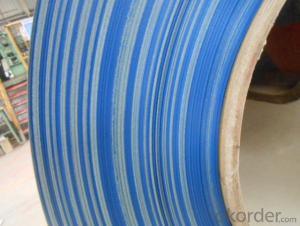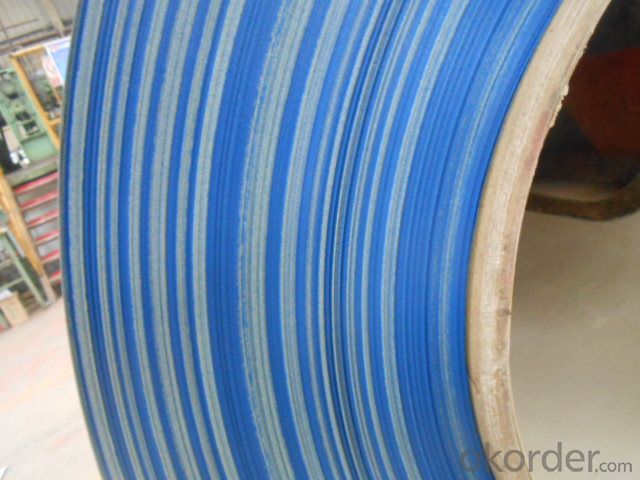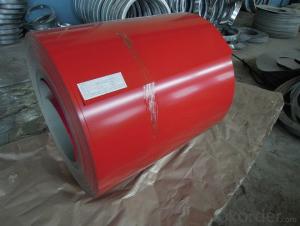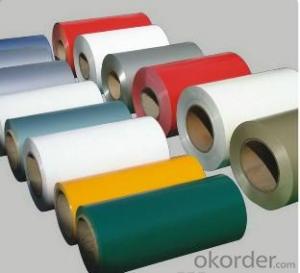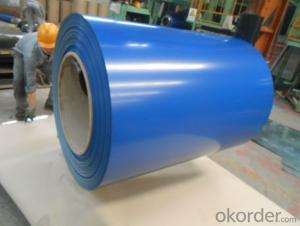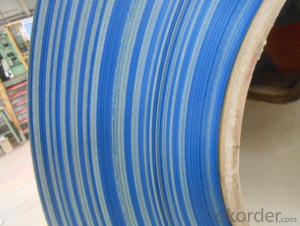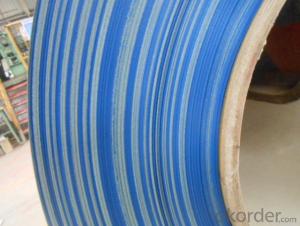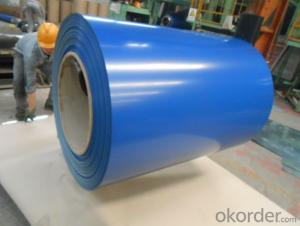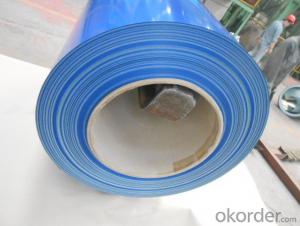PPGI,Pre-Painted Steel Coil with Prime Quality Blue Color
- Loading Port:
- Shanghai
- Payment Terms:
- TT or LC
- Min Order Qty:
- 200 m.t.
- Supply Capability:
- 20000 m.t./month
OKorder Service Pledge
OKorder Financial Service
You Might Also Like
1. Pre-Painted Galvanized/Aluzinc Steel Coil Description:
With GI as base material, after pretreatment (degrease and chemical treatment ) and liquid dope with several layers of color, then after firing and cooling, finally the plate steel is called pre-painted galvanized (aluzinc) steel. Pre-painted galvanized steel is good capable of decoration, molding, corrosion resistance. It generally displays superior workability, durability and weather resistance.
2.Main Features of the Pre-Painted Galvanized/Aluzinc Steel Coil:
• Excellent process capability
• Smooth and flat surface
• Workability, durability
• Excellent heat resistance performance
• High strength
• Good formability
• Good visual effect
3.Pre-Painted Galvanized/Aluzinc Steel Coil Images
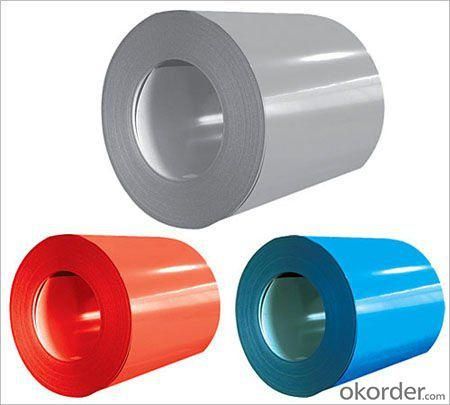
4.Pre-Painted Galvanized/Aluzinc Steel Coil Specification
Standard: AISI, ASTM, BS, DIN, GB, JIS
Grade: DX51D, DX52D
Thickness: 0.17-2.0mm
Brand Name: KMRLON
Model Number: coil
Type: Steel Coil
Technique: Cold Rolled
Surface Treatment: Coated
Application: Boiler Plate
Special Use: High-strength Steel Plate
Width: 20-1250mm
Length: customized
commoidty: pre-painted galvanized steel coil
Thickness: 0.13-4.0mm
width: 20-1250mm
zinc coating: 40-180g/m2
printing thickness: top side: 20+/-5 microns, back side: 5-7 microns
color: all RAL color
surface treatment: color coated
coil weight: 4-7 tons
coil ID: 508/610mm
packaging: standard seaworthy packing
5.FAQ of Pre-Painted Galvanized/Aluzinc Steel Coil
1. What’s the application of this product?
Roof, roof structure, surface sheet of balcony, frame of window, etc.
2. What’s the brand of the paint?
We use the best brand of all of the word—AKZO.
3. How to guarantee the quality of the products?
We have established the international advanced quality management system,every link from raw material to final product we have strict quality test;We resolutely put an end to unqualified products flowing into the market. At the same time, we will provide necessary follow-up service assurance.
4. How long can we receive the product after purchase?
Usually within thirty working days after receiving buyer’s advance payment or LC. We will arrange the factory manufacturing as soon as possible. The cargo readiness usually takes 15-25 days, but the shipment will depend on the vessel situation.
- Q: 7850kg/cu.m density is typical for all type of steel? like reibar, I- beam and so on
- 90% of the steels used today are plain mild carbon steels consisting of iron with less than 1% carbon content and as such have a density of about 7750 kg/cubic meter. Some special steels which have a significant percentage of alloying elements such as chrome or manganese or other elements will have greater density bringing the steel up to about 8000 kg / cubic meter. There are a greater many factors influencing the exact density of a steel. Even for steels of exactly the same content of iron , carbon and other alloying elements, there may be a difference ( very small mind you ) in density due to work hardening. The difference in this case is due to movement of dislocations which become locked in the grain boundaries and this forms a more dense crystal structure. For this same reason, the theoretical density of steel (which does not take into account dislocations) is greater than the measured density of steel.
- Q: Can steel coils be coated with self-cleaning materials?
- Yes, steel coils can be coated with self-cleaning materials. These materials, typically hydrophobic or photocatalytic coatings, can help prevent the accumulation of dirt, grime, and other contaminants on the surface of the steel coils. This not only maintains the aesthetic appeal of the coils but also reduces the need for frequent cleaning and maintenance.
- Q: What are the different coil slitting methods used for steel coils?
- There are three main coil slitting methods used for steel coils: rotary shear slitting, loop slitting, and oscillating slitting. Rotary shear slitting involves using rotating knives to cut the steel coil into narrower strips. Loop slitting is a process where the coil is looped through a series of rolls, and the desired width is achieved by adjusting the tension in the loop. Oscillating slitting is another method where the steel coil is passed through a set of oscillating blades, resulting in precise and high-speed slitting. These methods offer various advantages and are chosen based on the specific requirements of the steel coil slitting process.
- Q: I want to save water $$, so I want to use frozen steel to cool my coke. possible or no?
- can't freeze it but ya can make it very cold
- Q: How are steel coils inspected for thickness and width accuracy?
- Steel coils are inspected for thickness and width accuracy using various methods such as ultrasonic testing, laser measurement systems, and manual measurements. Ultrasonic testing involves the use of sound waves to measure the thickness of the coil, while laser measurement systems provide precise width measurements. Additionally, manual measurements are also conducted by trained inspectors who use specialized tools to ensure the accuracy of thickness and width dimensions.
- Q: Is sterling silver better than surgical steel as far as being hypoallergic in earrings? If I have a choice which should I get? Thanks!
- Surgical okorder /
- Q: What are the different types of steel coil recoiling methods?
- There are three main types of steel coil recoiling methods: slit edge recoiling, mill edge recoiling, and oscillated recoiling.
- Q: What are the dimensions of steel coils used in automotive component manufacturing?
- The dimensions of steel coils used in automotive component manufacturing vary depending on the specific application and requirements. However, common dimensions include thicknesses ranging from 0.5mm to 3mm and widths ranging from 600mm to 2000mm.
- Q: How are steel coils annealed for improved properties?
- Steel coils are annealed for improved properties by heating them to a specific temperature and then slowly cooling them down. This process, known as annealing, helps to relieve internal stresses in the steel, increase its ductility, and improve its machinability.
- Q: How are steel coils processed before being used in manufacturing?
- Steel coils undergo several processing steps before they are used in manufacturing. The first step is to uncoil the steel coil, which involves unwinding it from a large spool. This is usually done using a machine called a decoiler. Once the coil is uncoiled, it is inspected for any defects or damages. After inspection, the steel coil goes through a process called leveling. This process involves passing the coil through a series of rollers to remove any unevenness or waviness in the steel. Leveling ensures that the coil has a uniform thickness and flat surface, which is crucial for further processing. The next step is to clean the steel coil to remove any impurities, such as rust, oil, or dirt. This is usually done by running the coil through a cleaning line, where it is treated with chemicals and water sprays. The cleaning process ensures that the surface of the coil is free from contaminants, which can affect the quality of the final product. Once the coil is cleaned, it may undergo additional processes depending on the specific requirements of the manufacturing process. For example, the coil may be annealed to improve its ductility and reduce its hardness. Annealing involves heating the coil to a specific temperature and then slowly cooling it. This process helps to relieve internal stresses and improve the steel's mechanical properties. After all the necessary processing steps are completed, the steel coil is ready to be used in manufacturing. It can be further processed into various shapes and forms, such as sheets, plates, or strips, depending on the specific requirements of the manufacturing process. These processed steel coils are then used in a wide range of industries, including automotive, construction, appliances, and machinery.
Send your message to us
PPGI,Pre-Painted Steel Coil with Prime Quality Blue Color
- Loading Port:
- Shanghai
- Payment Terms:
- TT or LC
- Min Order Qty:
- 200 m.t.
- Supply Capability:
- 20000 m.t./month
OKorder Service Pledge
OKorder Financial Service
Similar products
Hot products
Hot Searches
Related keywords
